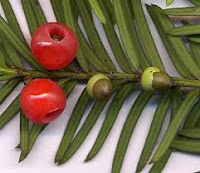The beech tree is a common sight in southern England and parts of South Wales. The name comes from the Old English Boc through to the Anglo-Saxon Boece and has left its mark on place names. There is the famous Burnham Beeches, near Slough, just outside London and Buckholt in Hampshire, and Buckhurst in Essex, both meaning ‘beech wood’ as well as Bockhampton in Berkshire which means ‘settlement where beech trees grow.’ The beech tree is a member of the Fagaceae family along with the oak trees, and sweet chestnut tree (Castanea sativa). “Fagos” is the Greek word which means to eat, and the trees are so-called because they bear edible nuts. In the case of the beech, these are known as beech masts, probably referring to the triangular shape of the two nuts that are contained in a prickly outer casing. The word sylvatica comes from the Latin for wood, sylvis. It is a distant relative of the witch hazel as they are part of the wider family of Hamamelidadae.
 |
| Copper beech |
The other beech tree that can be found in the British Isles is the Copper beech (Fagus sylvatica var. purpurea) which is a spectacular tree with purple-copper leaves. These can be dried and preserved with glycerine to make attractive decorations.
The nuts from the tree are bitter tasting, but I used to enjoy looking for them when I went for walks up the mountain with my grandfather, who would open the cases for me. We would often see squirrels in the tree, and badgers and small rodents would feed on then nuts when they fell. Apparently they are toxic and you shouldn’t eat too many of them.
 In times of scarcity the nuts can be ground to powder and used with flour to make bread etc. They can also be roasted and ground as a coffee substitute. It is said that the oil extracted from the nuts can be used to stimulate hair growth too.
In times of scarcity the nuts can be ground to powder and used with flour to make bread etc. They can also be roasted and ground as a coffee substitute. It is said that the oil extracted from the nuts can be used to stimulate hair growth too. The tender young shoots and leaves may also be eaten raw in a mixed salad, so the tree provides ‘famine food’ for humans and in autumn, food for animals and birds. In that season its leaves are golden and are a wonderful sight with the sun streaming through them.
The tender young shoots and leaves may also be eaten raw in a mixed salad, so the tree provides ‘famine food’ for humans and in autumn, food for animals and birds. In that season its leaves are golden and are a wonderful sight with the sun streaming through them. The branches can produce a creosote or tar through a dry distillation process, which is a stimulant, antiseptic and expectorant, which can be used also for skin diseases. It is said that the pure creosote brings fast relief from toothache, but it tastes vile.
 The leaves may be boiled and made into a hot poultice for headaches, while the buds of the beech tree are said to help the kidneys function well as well as having diuretic properties.
The leaves may be boiled and made into a hot poultice for headaches, while the buds of the beech tree are said to help the kidneys function well as well as having diuretic properties. It has been found that there are lignans in the bark of the tree, which have powerful antioxidant properties. These are found in flax seeds, pumpkin seeds and broccoli among other vegetables. It also contains suberin which is a fatty, waxy substance which gases and water cannot permeate, found in cork.
 |
| Beech in autumn |
Pollen from the catkins (flowers) of this tree has been found in fossils from the Pleistocene period, so like the yew it is a prehistoric tree. It has male and female flowers on the same tree, like the hazel.
This tree can grow to heights of 40 metres and is a shade tree, it lets little light through to the forest floor, and beech woods are very dark places. Beeches grow along with oaks and hazel trees in ancient woodlands in Britain. They can live for at least 300 years, but are babies in comparison to the ancient yews and Jurupa oak in California.


















